跨文化交际chapter2
chapter 2跨文化交际

Receiver response(信息接收者反应):The receiver is the person who
response of which the source has knowledge and to which the source attends and assigns meaning.
Context(情境): The final component of communication is context.
Chapter 3 Communication
c. Communication is symbolic(符号性的)
Symbols are central to the communication process because they represent the shared meanings that are communicated. Symbols are vehicle by which the thoughts and ideas of one person can be communicated to anther person.
Noise (干扰)
The term noise technically refers to anything that distorts the message the source encodes.
Noise can be of many forms: Chapter 3 Communication
跨文化交际导论(英文版)(第二版) Chapter 2 communication and culture
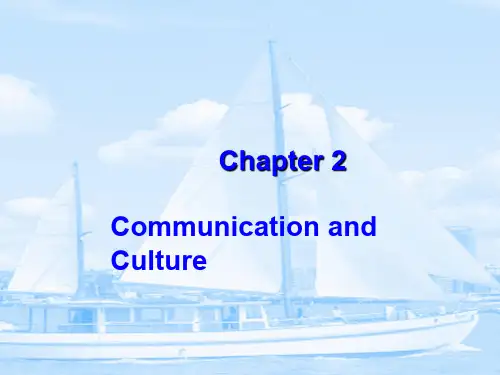
The Selected Scene ---Conflicts Across Border
Task:
(1) Is there an effective communication between Santiago and the police?
(2) What caused the conflicts between them and how to avoid such conflicts?
Decode
Physical
Message Channel
Channel Message Feedback
Encode Receiver
Encode
Reasons for Misunderstanding
Encoding & Decoding
Not all communication could
Section 2 1. Basics of Communication
Warm-up questions
What is communication? How would two people in love let each
other know about their feelings? How many Chinese words can you
通信
传通
1.1 Definition of Communication
Communication
Latin word “communicare”
Act and process of sending and receiving messages among people
Means of Communication
unit 2 跨文化交际课件
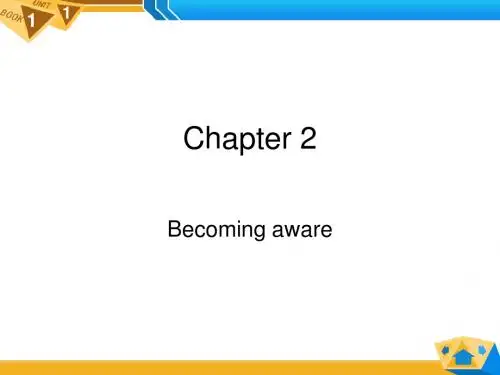
1
1
Chapter 2: Becoming aware
• 3. Characteristics of culture
• Culture is the total accumulation of beliefs, customs, values, behaviors, institutions and communication patterns that are shared, learned and passed down through the generations in an identifiable group of people.
1
1
Chapter 2
Becoming aware
1
1
Chapter 2: Becoming aware
• 1. What is culture? • The first step in learning to communicate across cultures, is to consider what people mean when they talk about culture. • The most usual meaning is that culture refers to people’s customs and behavior.
1
1
Chapter 2: Becoming aware
Level 1: Cultural differences are exotic Level 2: Cultural differences are frustrating Level 3: The different culture is believable Level 4: The different culture is believable as lived experience.
chapter 2商务英语专业跨文化交际第2章 案例 理论 习题答案
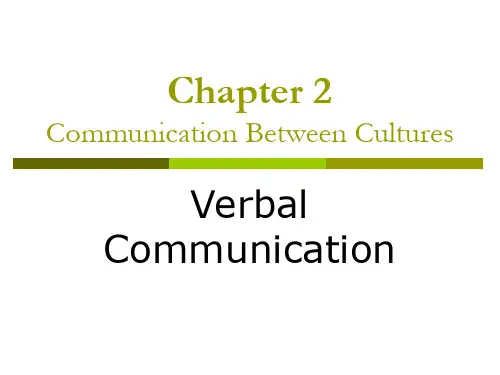
receiver
A symbol of wisdom as wise as an owl
D=D C‡C
猫头鹰 A symbol of bad luck
More examples
风水,经脉,知识份子,干部,……
公&母
Generic term chicken Duck goose male cock, rooster Drake gander female hen Duck goose young chick Duckling gosling
America
A place where law talks!
Joke appreciation for cultural diversity
3.
Before the man saying sorry, the woman covered the torn part of the skirt with a newspaper in hand and shyly said: “Sir, can you send me home? It is not very far from here.” Then the young man put his coat on the girl and called a taxi to send her home.
hot and irritable
Wuhan
Joke appreciation for cultural diversity
6.
The man felt very embarrassed and made a sincere apology to the girl. But the beautiful girl smiled and said: __________________________
跨文化交际基础 (2)
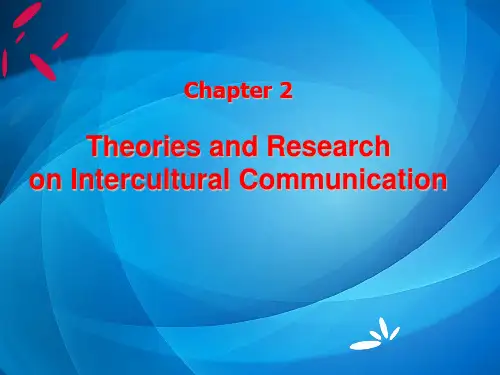
Key Terms
38.Internal / External 39. Triandis’s Cultural Dimensions 40. Four attributes of individualism–collectivism 41. Horizontal individualist (HI) 42. Vertical individualist (VI) 43. Horizontal collectivist (HC) 44. Vertical collectivist (VC) 45. Schwartz´ Universal Values Orientations
Neuliep’s Contextual Model
CHAPTER 2 2 Key Terms
Key Terms
1. Low-context culture 2. High-context culture 3. Values orientation theory 4. Five Basic Types of Problem and Three
Chapter 2
Theories and Research on Intercultural Communication
CHAPTER 2
A nation's culture resides in the hearts and in the soul of its people.
Mahatma Gandhi
Key Terms
15. Uncertainty Avoidance 16. High uncertainty avoidance culture 17. Low uncertainty avoidance culture 18. Long-Term Orientation (LTO) 19. Time Value Dimension 20. Long-term orientation culture 21. Short-term Orientation culture 22. Indulgence versus Restraint (IVR)
跨文化交际导论课件2
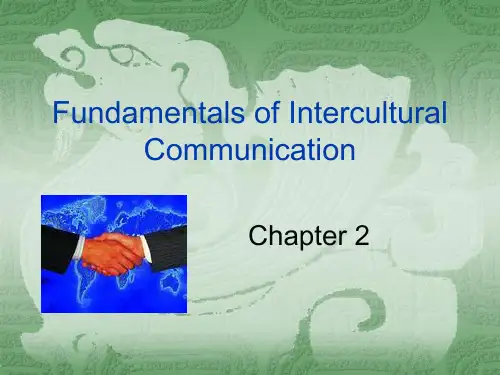
Further Explanation
There are at least two or more people: In terms of who communicate with whom, whether it being human, animals or machines, the classification is as follows: Human communication Animal communication Human-animal communication Human-machine communication Machine-to-machine communication
Further Explanation
There is a language shared between communicators.
Human language
Verbal
Nonverbal
Non-word sounds
Body language
e.g. Chinese, English
e.g. Sounds uttered to control
III. The Classification of Communication
Communication occurs when – there are at least two or more people. there is some contact between communication. there is a language shared by communicators. there is an exchange of information that has taken place.
跨文化交际第二章
Chapter 2: Language Use and CommunicationCommunication----our ability to share our ideas and feelings----is the basis of human contact.The results and the methods of communication might be different, but the process is the same.Human Communication•Intentional and Unintentional Behavior•Gerald Miller and Mark Steinberg think communication is not a random activity that happens by chance, but rather something that is systematic and planned•while other scholars believe communication takes place whenever people attach meaning to behavior, even if the sender of the message does not expect his or her actions to be communicated. •Communication occurs whenever meaning is attributed to behavior or the residue of behavior.•The Components of Communication1.The Source2.Encoding3.The Message4.The Channel5.The Receiver6.Decoding7.Feedback•A Source: is a person who has a need to communicate. This need may be conscious or unconscious.•Encoding:Because feelings and ideas cannot be shared directly, we must use symbolic representations. we select and arrange verbal and nonverbalsymbols according to our rules of grammar and syntax.•The Massage: encoding produces a message ,which is a set of verbal and nonverbal symbols that a source’s state of being at a par ticular moment. The message is external to the source, while encoding goes on inside the source.•The Channel: the means by which the message move from one person to another is the channel,and the primary channels are sound and sight.•The Receiver: is a person or persons who take the message into account .•Decoding: The receiver decodes the raw energy he or she takes in from the external world and converts it into meaningful experiences. It is information processing. Decoding permits the receiver to attach meaning to the source’s behavior.•Feedback: This is information generated by the receiver and made available to a source that allows the source to make qualitative judgments about the communication while it is taking place.Pragmatics:Language Use•The ProblemLinguistic communication is easily accomplished but not so easily explained.Problems with the message model•1. Disambiguation•2.Under-determination of reference•3.Under-determination of communicative intent•4.Non-literality•5.indirection•6.non-communicative acts•Disambiguation: The message model must be supplemented by principles of contextual appropriateness to compensate for the pervasive ambiguity of natural language.•Example: Flying planes can be dangerous•At an airport zoning, this sentence means the planes flying overhead is dangerous.•At the Pilot’s Insurance Board, this sentence means the risk of piloting planes.•Under-determination of reference:The message model must be supplemented by mechanisms for successfully recognizing the intention to refer to a specific person, place,or thing•Example: the shrewd politician.•Under-determination of communicative intent:•Example:I’ll be there tonight•It might be a prediction, a promise, or even threat, depending upon the speaker’s intentions in the appr opriate circumstances.•Non-literality: we may not mean what our words mean.•Example:Oh that’s just great.•Indirection:A speaker can use the very same sentence to convey quite different messages depending on the context•Example:My car has a flat tire.•It might means requesting a help.•Non-communicative acts: per-locutionary act.Example:•“Raise your hands if you agree!”Dr.William N.Brown begs his Chinese graduate students.•No response.•“Then raise your hands if you disagree!”•Still nothing•“How about raising your hands if you’re awake?”•Some glance about awkwardly, but none dare raise their hands, or break the silent vigil they’re since primary school.•An Inferential adj.可以推论的,据推论得出的Approach to Communication proposes提出four presumptions as the basis of an account of successful linguistic communication.•1.Linguistic Presumption•municative Presumption•3.Presumption of Literalness•4.Conversational Presumptions•Conversational Presumptions:•Relevance : the speaker’s remarks are relevant to the conversation.•Sincerity: the speaker’s is being sincere.Truthfulness: the speaker is attempting to say something true. •Quantity: the speaker contributes the appropriate amount of information.•Quality: the speaker has adequate evidence for what she says.Four characteristics of human language•1.Symbolic•2.rule-govern3.subjective(the meaning of language are reside in people not in words) •4.dynamic•Language is a part of culture ,culture is carry on by language.The Characteristics of Communication 8•No direct mind-to-mind contact•We can only infer•Communication is symbolic•Time-binding links us together•We seek to define the world•Communication has a consequence•Communication is dynamic•Communication is contextual•Communication is self-reflectiveThe Brain is an open system•Each of us can learn new ideas throughout life,what we know at any one instant is a product of what the brain has experienced.•We can learn from each other•Learning is a lifelong endeavor, we can use the information to which we are exposed to change the way we perceive and interact with the world. We are alike and we are different•We are identical in numerous physiological and chemical ways. We all have a heart, lungs,brain,and the like.we are also literally made of the same stuff:water,salt,and so on. We also seek emotional pleasure and flee injury to our feelings. We are also alike because all of us, regardless of our culture,must eventually face four fundamental issues: 1.life is finite 2.we are isolated from all other human beings 3.we need to make choices 4.the world is a meaningful world•We are different, because each of us is unique and is shaped by countless factors. Our experience of the world is internal, therefore, we each respond to the world differently.In a word, a common beginning, gender, age, culture and the like may bind us, but our isolated minds and unique experience keep us apart. Cultural differences also keep us apart. While the four philosophical issues of death, isolation, free choice and meaning confront everyone, the resolutions we decide upon have their roots deep in each culture.。
跨文化交际2
While in Japanese, you can only understand the affirmative or negative meaning after the speaker has finished the sentences.
Tense The dog bit the man in English Dog bite man in Chinese
Synonyms 同义词 Idioms习惯用语 Proverbs谚语 Styles / Varieties Slang, Taboo Expressions俚语 禁忌语 Euphemisms委婉语
2.1.2 MORPHOLOGY
A morpheme if the small unit of a language that has a meaning.
-s in dogs, means plural un- means negative in undo er-means who does it in teacher
Even the natives speak different sublanguages with utterly different sounds.
b (便), 2. p (边), 3. p' (片), 4. m (面), 5. f (火), 6. v (武), 7. d (电), 8. t (店), 9. t' (天), 10. n (呢), 11. l (连), 12. g (个), 13. k (该), 14. k' (开), 15. h (海), 16. ɦ (孩), 17. ŋ (呆), 18. tɕ (尖), 19. tɕ' (千), 20. ɕ (先), 21. dʑ (健), 22. ȵ (念), 23. j (夜), 24. ts (鸡), 25. ts' (溪), 26. s (输), 27. dz (住), 28. z (事), 29. 0 (无声母) 韵母 1. ɿ (志), 2. i (天), 3. u (火), 4. y (女), 5. a (板), 6. ia (晓), 7. ua (弯), 8. ɛ (杏), 9. iɛ (叫), 10. uiɛ (奣), 11. e (改), 12. ə (毛), 13. ø (看), 14. uɔ (炒), 15. yɔ (重), 16. o (巴), 17. yo (玉), 18. ai (北), 19. iai (吸), 20. uai (㾯), 21. ei (非), 22. au (斗), 23. iau (久), 24. ɣu (左), 25. ieu (手), 26. øy (夫), 27. aŋ (本), 28. ianŋ (斤), 29. uaŋ (温), 30. eŋ (井), 31. oŋ (送), 32. yoŋ (中), 33. m (?(轻 音)), 34. n (唔(轻音)), 35. ŋ (儿(轻音))
跨文化交际unit 2 课件
Unit parison of Chinese and Western cultural values Section 1. Definition of values▪What are values?▪V alues are broad, abstract concepts which provide the foundation that underlies a people‘s entire way of life.▪V alues are a learned organization of rules for making choices and for resolving conflicts. These "rules" and guideposts are normative and teach us what is useful, good, right, wrong, what to strive for, how to live our life, and even what to die for.Types of values▪1. Universal values▪2. culture-specific values▪3. individual valuesExercise: point out the values reflected in the following proverbs▪1. Blood is thicker than water. (origin: Scotland)▪(the bonds of family and common ancestry are stronger than those bonds between unrelated people ,such as friendship) family, loyalty▪2. Sauce for the goose is sauce for the gander. (origin: England)▪(if a particular type of behavior is acceptable for one person, it should also be acceptable for another person ) fairness▪3. Too many cooks spoil the broth. (origin: England)▪(The combined efforts of the group end up with something that is not so pleasant to eat) the individual4. The early bird catches the worm. (origin: England)▪(Success comes to those who prepare well and put in effort.) action▪5. God helps those who help themselves. (origin: Greece)▪(We can rely on nobody but ourselves) self-helpCautionTwo noteworthy features of values▪1. Contradictory values are found in a particular cultue.▪E.g.All people are created equal.▪E.g Sweep the snow in front of his door, and not bother about the frost on his neighbor‘s roof.▪A gulf between the values that are articulated (idealism) and the values that are acted out (reality)▪2. V alues of a culture change with time.V alues▪Five orientations proposed by American anthropologist, Florence Kluckhohn▪Human NatureChinese value on human nature▪Man, by nature, is good; people‘s inborn characters are similar, but learning makes them different;▪The story of Mencius‘ mother moving three tim es in order that her son could be in a good neighborhood;▪Y our character will be tinted ―red‖ if you are in the company of redness, but ―black‖ if you are in close contact with ink.▪安于现状,知足常乐,仁者爱人,仁至义尽▪Relationship of human to natureChinese traditional medicine shows the cultural value of harmony with nature▪Westerners: A minor illness like cold - work as usual; human body is an object that can be studied and then controlled---leading to the invention of powerful medicines, but the medicines may have unpleasant or even dangerous died effects.▪Chinese: cold- stayed home to give body a chance to recover. The human body is part of nature and needs to be brought back into balance. Medi cine should work with the body‘s own resources. It should be integrated with the body, so it will take longer to work.▪Sense of timeActivity---case study▪When a middle age American couple showed up to help a young Chinese couple move into their new apartment, they were surprised that the Chinese couple would not allow them to do any work. Instead they found a place for them to sit and gave them tea.▪Why?▪Activityconflict▪Westerners: experience the talk and behavior of Chinese people as performance, as dramatization of the self and as not very relevant to what is important; their conversation is lacking in information.▪Chinese: showing that they are friendly, virtuous, or sufficiently important; they are educated, polite, humble, high-ranking or hospitable.▪―我爸是李刚。
chapter 2跨文化交际贾玉新
The process of learning to be an anthropocosmic person
What do we need under today’s multi linguistic society? P28
intercultural communications
intercultural communications
❓
a commonly shared future
a commonly shared future
a global communicative and dialogic ethic
genuine intercultural dialogue
anybody • dynamic:rather than static
“Learning to be human” process
self-as-center relationship
• the human self embraces social and moral responsibilities and obligations for other, the world,and the cosmos.
• independence • autonomy • dichotomy
仁: a continuous, holistic and dynamic way of learning to be human P24-25
• continuous: always on the way of learning to be human • holistic: embracing the whole of humanity, do not exclude
- 1、下载文档前请自行甄别文档内容的完整性,平台不提供额外的编辑、内容补充、找答案等附加服务。
- 2、"仅部分预览"的文档,不可在线预览部分如存在完整性等问题,可反馈申请退款(可完整预览的文档不适用该条件!)。
- 3、如文档侵犯您的权益,请联系客服反馈,我们会尽快为您处理(人工客服工作时间:9:00-18:30)。
Communication Defined
Components of Communication
Dynamic Systemic Symbolic Irreversible Transactional Self-reflective Contextual
Intercultural Communication Defined Forms of Intercultural Communication
In western cultures, communication is studied as the
means of transmitting ideas. Western cultures emphasize the instrumental function of communication; that is, effectiveness is evaluated in terms of success in the manipulation of others to achieve one’s personal goal.
Eastern perspective of communication
Definitions of communication from many Asian countries stress harmony, which is most notable in cultures with a Confucian tradition. Eastern cultures’ understanding would define communication as a process where all parties are searching to develop and maintain a social relationship.
Text B Characteristics of Communication
a. Communication is dynamic b. Communication is systematic c. Communication is symbolic d. Communication is irreversible e. Communication is transactional f. Communication is self-reflective g. Communication is contextual.
(4) Semantic Noise
caused by using different languages; the use of jargon; different understanding of the message delivered; etc.
Context (语境) •The physical context: location
2. Components of communication
Sender/Source (信息源) A sender/source is the person who transmits a message. Message (信息) A message is any signal that triggers the response of a receiver. Encoding (编码) Encoding refers to the activity during which the sender must choose certain words or nonverbal methods to send an intentional message. Channel /Medium (渠道) Channel/Medium is the method used to deliver a message
(1)External Noise
Sounds that distract communicators: voices in the next room; annoying ring of someone’s cell phone in a meeting; etc. Other types of external noise that don’t involve sound: an overcrowded room or a smelly cigar
c. Communication is symbolic
(符号性的)
Symbols are central to the communication process because they represent the shared meanings that are communicated. A symbol is a word, action, or object that stands for or represents a unit of meaning. People's behaviors are frequently interpreted symbolically, as an external representation of feelings, emotions, and internal states.
People have shared expectations on what interactions are proper and what are not in different kinds of relationships between communicators, like teacherstudent, parent-child, boss-subordinate, etc. 不同人际 关系下的行为方式
Lead-in Case: She Has Three Hands
Suppose you are the Chinese doctor, if you are communicating with the Canadian physiotherapist, how would you respond to the situation? What caused their communication conflicts? What do you think of the different communication styles of the two doctors?
a. Communication is dynamic
Communication is an ongoing activity. It is not fixed. A word or action does not stay frozen when you communicate; it is immediately replaced with yet another word or action.
Text A:
Communication
Text A:
Communication
The word communication is derived from the Latin word “communicare” meaning to share with or to make common. The study of communication is said to have begun some 2500 years ago in Greece with Aristotle’s Rhetoric and Poetics, which described the process of communication as involving a speaker, the speech act, an audience and a purpose.
.
Receiver (信息接收者)
A receiver is any person who notices and gives some meaning to a message.
Decoding (解码)
Decoding is the activity during which the receiver attaches meaning to the words or symbols he/she has received.
Learning objectives:
Communication and Intercultural Communication
Communication来自Characteristics of Communication
Culture and Communication
Intercultural Communication
b. Communication is systematic
(系统性的)
Communication does not occur in isolation or in a vacuum, but rather is part of a larger system. We send and receive messages not in isolation, but in a specific setting. Setting and environment help determine the words and actions we generate. Dress, language, topic selection, and the like are all adapted to context.
(2) Physiological Noise
illnesses and disabilities
(3) Psychological Noise
forces with the sender or receiver that interfere with understanding: egotism; hostility; preoccupation; fear; etc.
